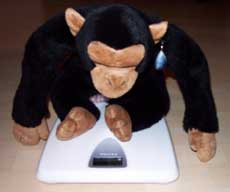
ATLAS e-News
23 February 2011
Has the SCT gained weight?
15 December 2008

Numbers of radiation lengths as a function of pseudorapidity.
Left: An example from the SCT end-cap of the contributions from the different components.
Right: The contributions from each of the Inner Detector sub-detectors within their own volumes.
If you are concerned about your own weight, some of us have been really concerned about our detector's weight! During the design and construction of the Inner Detector, great effort was made to reduce the amount of material, especially at the lowest radius where it causes greatest harm: The material causes multiple-scattering, thus modifying the measured track-parameters; electrons lose energy by bremsstrahlung, photons convert, hadrons have nuclear interactions; and the energy seen by the Electromagnetic Calorimeter is degraded. Unfortunately there is more material than we all would like.
Alas, with the design parameters of the LHC, significant amounts of material are difficult to avoid. Because of the machine’s time-structure, fast readout is needed, requiring electronics in the heart of the tracking volume. Electric power must be supplied by metallic conductors and with the high-readout rates, much heat is generated in the front-end chips, in turn requiring substantial cooling. To support the services and ensure that the sensors are stable in space to the order of one micron requires substantial supports.
With this situation, it is important to ensure a good description of the detector in the ATLAS Offline Simulation. Firstly much work has gone into estimating the amount and nature of the material; secondly the details of the components (size, position, mass, composition) have been described in terms of Geant-4 volumes in the software. The target proposed in the Technical Design Report was to achieve a precision on the mass estimates of about 2% – this is very challenging. In the SCT, we set ourselves the goal of determining the mass and composition of every single item in the detector. Most parts larger than ~1 cm3 or 1 gram were associated with a specific Geant-4 volume – smaller components were combined with others. Similar tasks were undertaken by others for the Pixels and TRT. We will describe here what was done for the SCT.
We spent ages staring at the detector components, photos and drawings. Wherever possible, components were weighed; as a last resort, masses were estimated from the CAD models. The information was gathered in many spreadsheets, documents and web pages and then given to Grant Gorfine and Pat Ward who captured the information in the software. We paid careful attention to the different chemical make-up of each component since this affects the ratio between radiation and interaction lengths.

No monkeying around: Everything in ATLAS had to be weighed carefully.
There were many cross-checks which were made, including weighing some assemblies. A heroic attempt was made to weigh the complete SCT inside the TRT – unfortunately with the accuracy available and uncertainty as to what was or was not included, it proved difficult to obtain definitive answers.
We estimate that each end-cap weighs 178 kg, with an additional 82 kg of services attached to the cryostat. The corresponding numbers for the barrel are 218 and 307 kg. These weights include the modules, support structures and all the services. The uncertainties are very difficult to estimate, but we believe they are less than 10 kg on each of the three sections of the SCT, with smaller estimates for the masses in the actual tracking volumes. The largest surprises came from the amount of glue used: what we weighed was far greater than we had estimated.
These estimates are the result of a huge amount of work by many people – thanks everyone! For more details, including the names of all those involved, see ATL-COM-INDET-2008-020.
The next task will be to estimate the material from the interactions of particles coming from collisions. This will be difficult, for example, conversion electrons will suffer from bremsstrahlung and an addition source of photons will arise from nuclear interactions creating pi-zeroes. So we expect it will be many months before there is sufficient confidence in these data-driven measurements to challenge our estimates. It will be interesting to see what we missed!

Stephen HaywoodRutherford Appleton Laboratory |

Alessandro TricoliRutherford Appleton Laboratory |